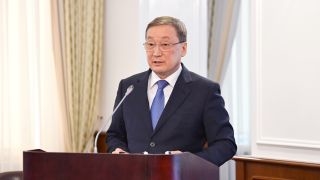
At the government session chaired by Prime Minister Askar Mamin, issues of water resources use were considered. Minister of Agriculture Saparkhan Omarov presented his report. The growing season of this year was difficult, said the head of the agricultural department.
According to him, this is evidenced by the numerous appeals of agricultural producers in the southern regions regarding the lack of water. Thanks to the measures taken by the Government and the well-coordinated work of akimats, the harvest was carried out without significant losses.
As Saparkhan Kesikbayevich noted, one of the important tasks is the rational and economical use of irrigation water on irrigated lands.
“So, according to the data of akimats, the area under crops in 2020 on irrigated lands amounted to 1.4 million hectares. More than 1.1 million hectares or 79% falls on the surface method of irrigation of crops. 104 thousand hectares are mainly rice fields, which are irrigated by the method of continuous flooding, and only 200 thousand hectares or 13.8% of the total area is used modern drip or sprinkler irrigation,” said the minister. A high percentage of the use of moisture-saving technologies is observed in Pavlodar, Karaganda, Akmola regions. This confirms the thesis of the Ministry of Ecology about the potential for the development of irrigated agriculture in the northern regions.
Saparkhan Omarov dwelled on the structure of the sown areas of irrigated lands. Thus, according to statistics, oilseeds, grains, fodder crops, vegetables and melons, cotton, potatoes, rice, and sugar beets are currently cultivated on irrigated lands. The main share is occupied by such rainfed crops as wheat and barley, as well as monocultures – cotton and rice.
Within the framework of the signed memorandums between the Ministry of Agriculture and the regional akimats, work is being carried out to diversify the sown areas of agricultural crops by reducing the share of water-intensive and monocultures, as well as increasing the area of highly profitable alternative crops. According to the minister, this year the area of cotton was 126 thousand hectares, which is 8.6 thousand hectares less than in 2017. A slight change is observed in rice: compared to 2017, the area has been reduced by only 700 hectares.
According to him, the main reason for not reaching the indicators is that the memorandum is of a recommendatory nature and does not apply to documents of the State Planning System. To resolve this issue, the Ministry of Agriculture has amended the sectoral Law "On State Regulation of the Development of the Agro-Industrial Complex and Rural Areas" in terms of including in the competence of the authorized and local executive bodies the norms for concluding an agreement (memorandum) on the diversification of the structure of sown areas of agricultural crops. Also, indicative indicators for the sown areas of demanded crops have been introduced into the State Program of AIC. This will increase the responsibility of regional akimats to achieve the indicators of the memorandums.
According to Omarov, the main reasons for the low rates of diversification on the part of agricultural producers are:
the ‘’social” component of crops;
lack of competence in cultivating other cultures and established sales markets;
soil salinity;
the current system of machines and the need to acquire new tools and other crops;
the low cost of water does not stimulate the purchase of water-saving technologies.
As the head of the Ministry of Agriculture explained, the work on diversification of cultivated areas will be coordinated on an ongoing basis, in this regard, the akimats should intensify work in this direction. At the same time, it should be noted that the indicator for reducing the area of rice in the Kyzylorda region has not been met.
So, according to the memorandum, the rice sowing area in the Kyzylorda region in 2020 was supposed to be 75 thousand hectares, but the actual sowing area was 89 thousand hectares, that is, the excess of the indicative indicators is more than 14 thousand hectares.
A similar situation is observed in the Almaty and Turkistan regions, where the excess is more than 500 hectares and 2.3 thousand hectares, respectively. Also, in the Turkistan region, the indicator on the reduction of the cotton area has not been met. So, in the current year the actual area of cotton has exceeded the area provided for in the memorandum by 16 thousand hectares.
In Kyzylorda and Turkistan regions, the indicator for the reduction of wheat area has not been fulfilled either. The wheat sown area in the Kyzylorda region this year has doubled the area provided for in the memorandum. A similar situation is in the Turkistan region, where the actual area annually exceeds the indicative indicators of the memorandum. Here the example of the Almaty region is indicative, where wheat areas have been reduced by 11 thousand hectares, thereby fulfilling the indicators of the memorandum. In order to stimulate farmers to use modern moisture-saving technologies, the ministry provides state support in the form of investment subsidies, which provides for reimbursement of 50% of the costs incurred for the purchase of modern irrigation systems, as well as the installation of all necessary infrastructure. Farmers are trained and knowledge disseminated, including through a network of demonstration farms created with the American company Valmont. The minister noted that the draft of the new State Program for Water Resources Management until 2030 provides for an indicator to increase the area where water-saving technologies are used to 750 thousand hectares. The full-scale introduction of water-saving irrigation technologies will allow rational use of irrigated lands with a decrease in water consumption and an increase in productivity.
Taking into account the need to bring the area of irrigated land to 3 million hectares, the Ministry of Agriculture of the Republic of Kazakhstan in 2018 developed a forecast structure of sown areas. This structure was brought to the regional akimats for implementation.
“In the specified forecast structure of agricultural crops, it is expected that the share of such water-intensive crops as rice to 75 thousand hectares and cotton to 100 thousand hectares is expected. It is also planned to reduce grain crops in the structure of crops in 2030 to 50 thousand hectares, and irrigation of grain is provided in the northern region in the fodder crop rotation,” Omarov reported.
According to him, the correct use of irrigated land will allow to fulfill the tasks set by the Head of State for the transition to the production of highly profitable crops, import substitution and for the gradual increase of the area of irrigated land to 3 million hectares by 2030.
Source: https://primeminister.kz/en/news/suarudyn-su-unemdeu-tehnologiyalaryn-engizu-su-shygynyn-azaytyp-onimdilikti-arttyruga-mumkindik-beredi-s-omarov-22112114


